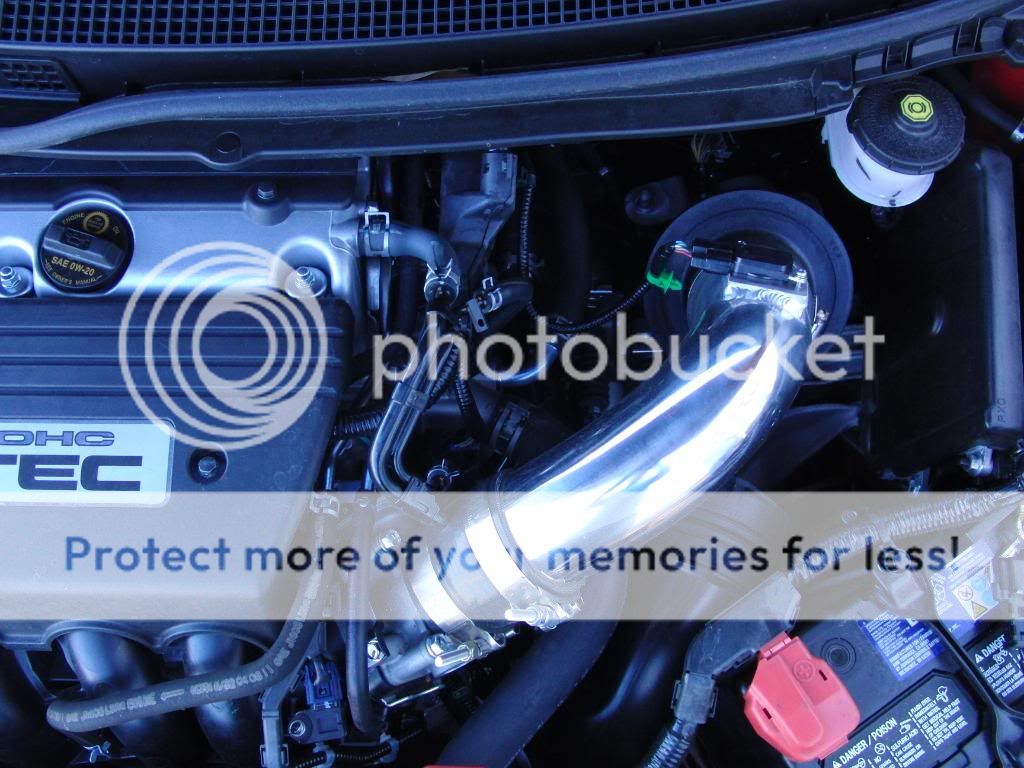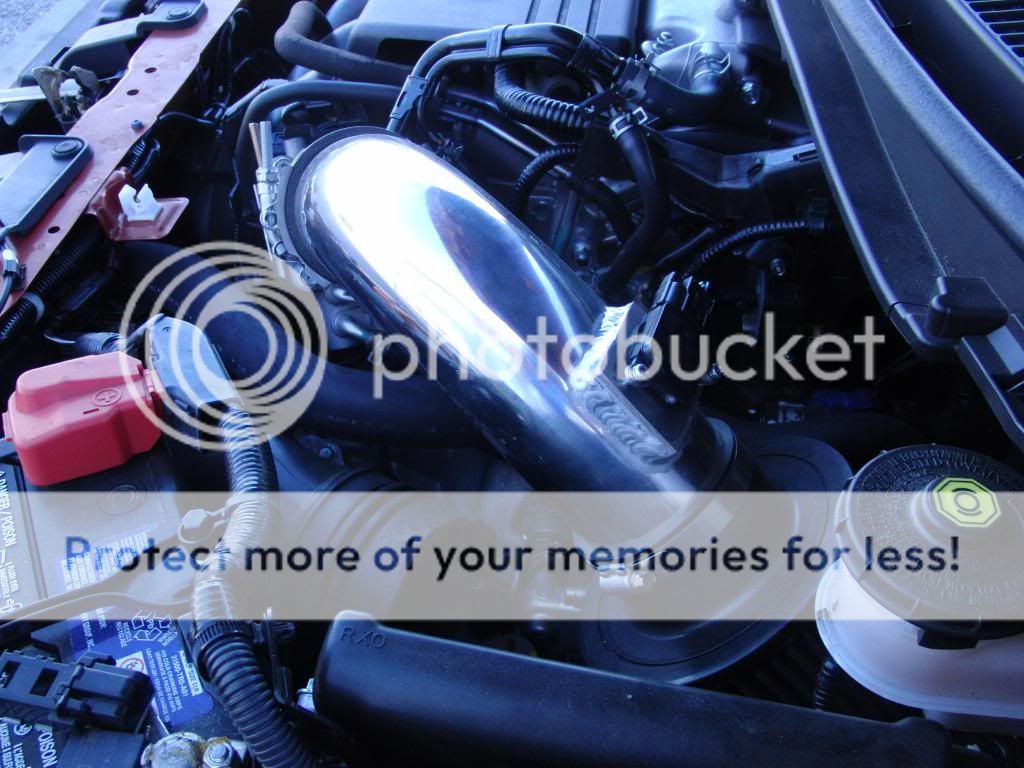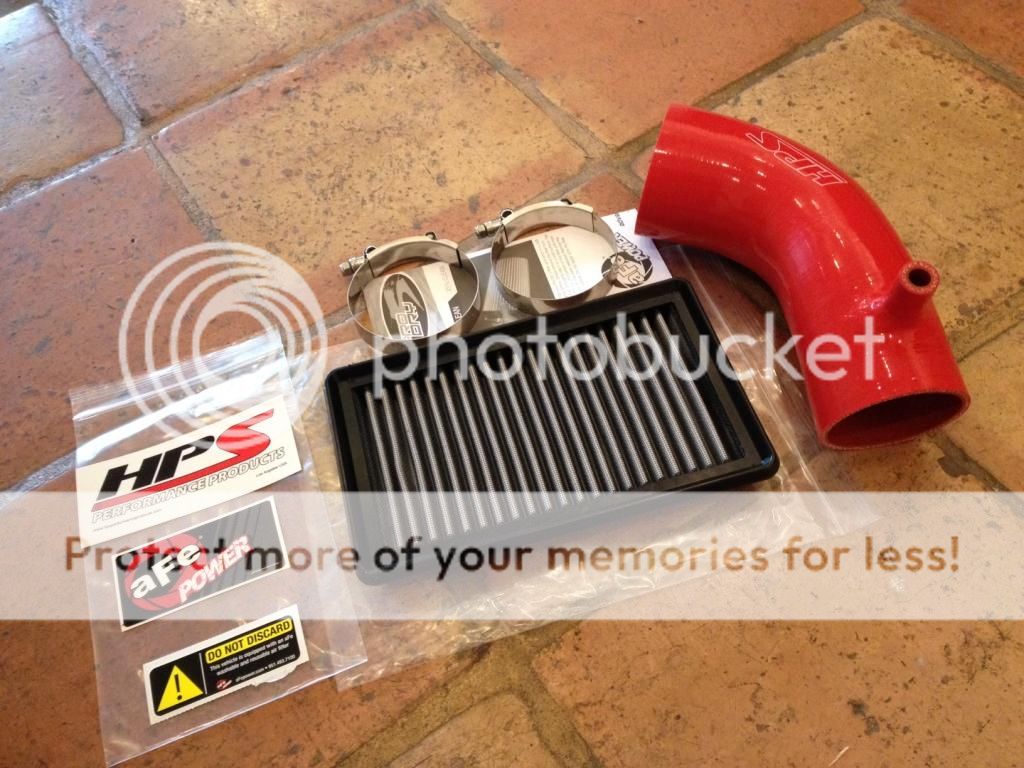Navigation
Install the app
How to install the app on iOS
Follow along with the video below to see how to install our site as a web app on your home screen.
Note: This feature may not be available in some browsers.
More options
You are using an out of date browser. It may not display this or other websites correctly.
You should upgrade or use an alternative browser.
You should upgrade or use an alternative browser.
Review and Clips of Intake Resonator Delete w/ K&N Filter
- Thread starter JayGeeisMe
- Start date
team3d
Well-Known Member
Sorry man but it doesn't create positive pressue. The only way to do that is forced induction or a ram air type setup.
In order to create pressure its true that there has to be restriction, but without forced induction the intake components after the resonator and filter (throttle body and intake manifold) are only sucking in air. By creating a restriction point before that (resonator) thats all your doing is creating a restriction.
The ram-air intake (cold air intake) works by reducing the intake air velocity by increasing the cross-sectional area of the intake ducting. When gas velocity goes down the dynamic pressure is reduced, while the static pressure is increased. The increased static pressure in the plenum chamber has a positive effect on engine power, both because of the pressure itself and the increased air density that this higher pressure gives.
here the link....
http://en.wikipedia.org/wiki/Ram-air_intake
- Thread starter
- #23
JayGeeisMe
Well-Known Member
.
Last edited:
team3d
Well-Known Member
That's really cool info and it's "educational" and all that...but it has nothing to do with my post. So guys please go create your own thread about educating people on Australian car radiators and how a resonator does nothing except muffle sound and debate it there. And leave my thread for people who want to discuss the resonator delete on the 9th gen Si. Thanks.
these post tells you why it's good to leave the resonator than removing it...
now you understand why you put it back instead of leaving it off...
when a person can't understand why stock resonator created air pressure, i explain it & offer a link....
so, yes, this is discussion for the resonator delete because you can't explain it why "little bottom end tq I felt to have lost"
- Thread starter
- #25
JayGeeisMe
Well-Known Member
.
Last edited:
team3d
Well-Known Member
if you don't want anyone to post, you can ask mod to lock the thread up. this is a public forum.
- Thread starter
- #28
JayGeeisMe
Well-Known Member
.
Last edited:
- Thread starter
- #29
JayGeeisMe
Well-Known Member
I'm just trying to prevent another age old debate of "the resonator does nothing but muffle noise vs. It has multiple functions". There's already threads for that. Besides this thread was dead a long time ago.I see nothing wrong with the progression of the discussion in this thread other than a bit of animosity developing.
Debate is good and healthy. You are not going to be able to stop it. It happens with many topics all the time.
Anyway, we all love our cars and want to learn as much about them as we can and occasionally someone comes along with new, valid, and relevant information that is useful.
Dead thread is no longer dead, btw.
Anyway, we all love our cars and want to learn as much about them as we can and occasionally someone comes along with new, valid, and relevant information that is useful.
Dead thread is no longer dead, btw.
- Thread starter
- #31
JayGeeisMe
Well-Known Member
Debate is good and healthy. You are not going to be able to stop it. It happens with many topics all the time.
Anyway, we all love our cars and want to learn as much about them as we can and occasionally someone comes along with new, valid, and relevant information that is useful.
Dead thread is no longer dead, btw.
That's the whole issue. Why "debate" about something that has been discussed many times in the past? There's no "new and valid" info being discussed here. Just talking in circles to develop a 20 page thread with maybe a few pages worth of valid info that's already on the forum somewhere. I didn't post this up for "debate". But hey you're right. I can't stop internet pissing contests. Guess I'll just do what I can to avoid it.
Bulkybear
Well-Known Member
- 1,665
- 749
This is correct, but it doesn't apply to our cars. Our cars don't have a ram air intake. Stock our intake isnt a restriction anyways so the only thing the resonator affects is the sound.The ram-air intake (cold air intake) works by reducing the intake air velocity by increasing the cross-sectional area of the intake ducting. When gas velocity goes down the dynamic pressure is reduced, while the static pressure is increased. The increased static pressure in the plenum chamber has a positive effect on engine power, both because of the pressure itself and the increased air density that this higher pressure gives.
here the link....
http://en.wikipedia.org/wiki/Ram-air_intake
In our car out intake sucks air in, there is no force applied to the incoming air before that.
A cold air intake and a ram air intake are 2 different things, also both different to a short ram intake. So yes you are right, but that doesn't apply to our cars, the resonators only purpose is to filter out the resonance of the intake sound in our cars. As far as losing bottom end torque, I just plain don't believe that with just removing the resonator.
team3d
Well-Known Member
This is correct, but it doesn't apply to our cars. Our cars don't have a ram air intake. Stock our intake isnt a restriction anyways so the only thing the resonator affects is the sound.
In our car out intake sucks air in, there is no force applied to the incoming air before that.
A cold air intake and a ram air intake are 2 different things, also both different to a short ram intake. So yes you are right, but that doesn't apply to our cars, the resonators only purpose is to filter out the resonance of the intake sound in our cars. As far as losing bottom end torque, I just plain don't believe that with just removing the resonator.
http://www.ehow.com/info_12156112_air-intake-resonator-do.html
Design and Construction
- The resonator itself couldn't be simpler in design; it's basically just an expansion chamber or wide spot in the otherwise-smooth intake pipe. It may or may not contain some kind of baffle or plate, depending upon the design and the intent of the designers. Resonators come in two types: In-line resonators are open chambers that sit in the intake tube, while side-branch resonators are chambers that sit next to the tube and are connected to it via a small duct or channel.
- Most hot-rodders and car enthusiasts think of intake resonators as simple mufflers in the intake tube, devices designed to siphon all the awesomeness out of a car's sound track to appease soccer moms and senior citizens. That makes it a prime candidate for the "chuck-it" school of auto modification. After all, it's basically just a plastic tumor growing off of a tube that should by definition be as smooth and blemish free as possible. While sound control is indeed part of the resonator's job, the sound control itself is really more of a side effect of its primary purpose.
- Air flowing into your cylinder head's intake port doesn't move in a straight line while the valve is open, then politely stop in its tracks to await another valve opening. When the valve closes, the moving column of air slams into it, then compresses and bounces back like a spring. This pressure wave travels backward at the speed of sound until the intake runner opens up or it hits something, and then it bounces back toward the cylinder. This is the "first harmonic." The pressure wave actually bounces back and forth two or three more times before the intake valve opens again.
- The resonator in your intake is technically known as a Helmholz resonator, an acoustic device used to control pressure wave harmonics. Air bouncing back out of your engine and into the intake tube doesn't do it in a single pulse the way it would in a single intake runner; the multiple pistons put out pressure waves at their own intervals, and some of those are going to try to bounce back in while others are going out. The result is a "clog" or high pressure area in your intake tube that ultimately limits airflow through almost the entire rpm spectrum.
- Adding an expansion chamber to the intake tube forces air coming back out of the engine to slow down to fill the cavity, thus expending a great deal of its energy and slowing the pressure wave reversion. This slowdown allows fresh air to flow toward the engine without fighting pressure reversion waves the entire way, thus aiding in cylinder filling. Since these pressure waves are essentially sound, giving them a place to expend their energy before exiting the air filter box ends up dampening the intake noise and quieting the engine. Thus, the resonator helps to make the engine paradoxically quieter and more powerful.
Read more : http://www.ehow.com/info_12156112_air-intake-resonator-do.html
Bulkybear
Well-Known Member
- 1,665
- 749
Ok. I stand corrected. Great read. One question then. How do aftermarket intakes allow for more power as you mod your motor? All they are are tubes with filters at the end. Is it because they really do flow that much more air?
Last edited:
team3d
Well-Known Member
here is the ART sri dyno... idroveacamery bought it & he race levin's 2012 lx coupe (manual)... one of the only 9th gen NA r18 that can keep up with stock si..
the real world result, idroveacamery lost by 5 car lanes.... ART intake actually worse than stock... we end up using my car & k24seven's si coupe to race idroveacamery & the result is all the same.... after he put the intake back to stock, he race levin again the following week and he was able to claim his manhood back....
it's why i don't sell parts base on internet descriptions, online feedback, photos or dyno...
we have to test everything before even post a group buy.. it's why we don't sell alot of products...
the real world result, idroveacamery lost by 5 car lanes.... ART intake actually worse than stock... we end up using my car & k24seven's si coupe to race idroveacamery & the result is all the same.... after he put the intake back to stock, he race levin again the following week and he was able to claim his manhood back....
it's why i don't sell parts base on internet descriptions, online feedback, photos or dyno...
we have to test everything before even post a group buy.. it's why we don't sell alot of products...
team3d
Well-Known Member
04/09/2012, post by "utah's first 2012si".... i just copy & paste...
http://www.***************/forum/images/icons/icon4.png Injen, AFE & ART Intake Photos and Dyno Charts for Si
Hello Kids,
I just wanted to merge the Injen, AFE and ART Intakes for the Si into one thread. I've attached photos, the dyno charts showing the "gains" and just added a little info from the manufacturer. Feel free to have your opinion of which is best, Personally I've owned a few intakes and Injen has been my favorite and proven to perform!
1. Injen CAI : Injen's statement on this intake: "The vehicle produces a consistent 10-12Hp and 11-13TQ throughout the entire power band . We saw gains as high as 19hp and 15 tq but we don’t advertise the highest gains like some of our competitors do. I included a dynograph just to show you that. We did 3 runs with the Injen intake and 3 runs with the stock air box. Both on the same day back to back to get the most consistent results."


http://www.***************/forum/attachments/bolt-ons-all-motor/4532d1333657989-injen-cai-injen-si-dyno.png
2. AFE Takeda Intake/Ice Box:
The all new Takeda Momentum Sealed Intake System produces up to 20HP and 18lbs. x ft. of torque over stock, while outflowing the factory intake by 42%. Unlike other Takeda intakes, this system uses a PRO 5R progressive mesh five layer filter for maximum airflow and convienence. This system uses a unique rotomolded sealed airbox designed to increase airflow using the factory ram air scoop for maximum torque in all weather situations.



3. ART SRI Intake: Sock Dyon = Peak HP and Torque, 177.7 & 165.8, With ART SRI Peak HP and Torque, 192 & 178.5


http://www.***************/forum/attachments/bolt-ons-all-motor/3507d1331178903-advanced-race-technology-has-cai-sri-9th-gens-intake-comparison.png
All seem to be very similar gains, Injen seems to be the most realist and the design looks smooooooooooooth! The AFE looks cool but I'm skeptical and it cost WAAAAAAY too much, Injen is cheaper. The ART Intake shows BIG gains for an SRI! To each their own. Trial and error is what it's all about. Lets all help each other out! And if your not cool with that, Well then . . . as D-Generation X would say, I have 2 words for you. . . Haha jk
http://www.***************/forum/images/icons/icon4.png Injen, AFE & ART Intake Photos and Dyno Charts for Si
Hello Kids,
I just wanted to merge the Injen, AFE and ART Intakes for the Si into one thread. I've attached photos, the dyno charts showing the "gains" and just added a little info from the manufacturer. Feel free to have your opinion of which is best, Personally I've owned a few intakes and Injen has been my favorite and proven to perform!
1. Injen CAI : Injen's statement on this intake: "The vehicle produces a consistent 10-12Hp and 11-13TQ throughout the entire power band . We saw gains as high as 19hp and 15 tq but we don’t advertise the highest gains like some of our competitors do. I included a dynograph just to show you that. We did 3 runs with the Injen intake and 3 runs with the stock air box. Both on the same day back to back to get the most consistent results."


http://www.***************/forum/attachments/bolt-ons-all-motor/4532d1333657989-injen-cai-injen-si-dyno.png
2. AFE Takeda Intake/Ice Box:
The all new Takeda Momentum Sealed Intake System produces up to 20HP and 18lbs. x ft. of torque over stock, while outflowing the factory intake by 42%. Unlike other Takeda intakes, this system uses a PRO 5R progressive mesh five layer filter for maximum airflow and convienence. This system uses a unique rotomolded sealed airbox designed to increase airflow using the factory ram air scoop for maximum torque in all weather situations.



3. ART SRI Intake: Sock Dyon = Peak HP and Torque, 177.7 & 165.8, With ART SRI Peak HP and Torque, 192 & 178.5


http://www.***************/forum/attachments/bolt-ons-all-motor/3507d1331178903-advanced-race-technology-has-cai-sri-9th-gens-intake-comparison.png
All seem to be very similar gains, Injen seems to be the most realist and the design looks smooooooooooooth! The AFE looks cool but I'm skeptical and it cost WAAAAAAY too much, Injen is cheaper. The ART Intake shows BIG gains for an SRI! To each their own. Trial and error is what it's all about. Lets all help each other out! And if your not cool with that, Well then . . . as D-Generation X would say, I have 2 words for you. . . Haha jk
Bulkybear
Well-Known Member
- 1,665
- 749
So you're saying the intakes do provide gains or don't? I don't really see much of a difference between a resonator delete and a CAI.
team3d
Well-Known Member
no, i don't see any real world improvements on the street....
i also believe vit viper also stated the stock air box is the best...
but on the race track, i believe it will make a difference....
this is the only intake set up i am selling right now (afe or k&n makes no difference)... & it's the only set up i will use on my personal car....

i also believe vit viper also stated the stock air box is the best...
but on the race track, i believe it will make a difference....
this is the only intake set up i am selling right now (afe or k&n makes no difference)... & it's the only set up i will use on my personal car....

